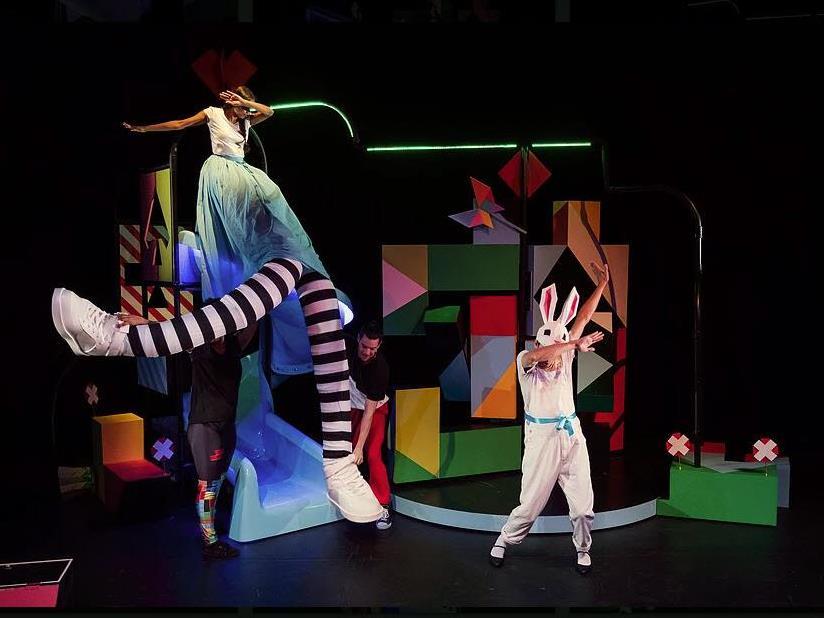Image: Alice in Wonderland at Sydney Festival 2018. Photo by Clare Hawley.
Don’t miss this marvellously contemporary reworked version of Alice in Wonderland as part of Sydney Festival at Riverside Theatres Parramatta. It’s not just for children (although, yes, they were enthralled) it’s also for adults who were giggling at the wry wit, and warm humour of the play. Alice in Wonderland is not only a whole lot of fun, it also has an important message for young people – about following your dreams.
Darwin-based playwright Mary Anne Butler has adapted the 150-year-old Lewis Carroll classic and made it Australian. It’s contemporary yet respects the original text. Words and phrases like ‘existential crisis’ and ‘DNA’ are placed in context within the dialogue, in a way which doesn’t feel patronising to the children in the audience.
The production is excellently directed by Cristabel Sved and led by Dubs Yunupingu as Alice – the first time the role has been played by an Indigenous woman, while the small cast of four energetically and enthusiastically bring Wonderland to life, incorporating straight drama, puppetry and dance.
Melanie Liertz’s set design – a children’s playground in heightened colours, parts of which shift and revolve – is bright and bold. The playground also allows for playful depiction of familiar story elements, such as Alice following the White Rabbit ‘down the rabbit hole’ by sliding on a blue slippery-dip. Costumes and props are extremely detailed.
Steve Toulmin’s vibrant soundtrack includes bells and chimes as well as foley effects. Matt Cox’s lighting is complementary and most effective.
The feisty Yunupingu is magnificent as Alice, a girl who just wants to play AFL but is hampered by the boys’ reactions (and those of the coach) and having to deal with the frustrations of society’s gender expectations. There’s a soft toy white rabbit lying lonely and melancholy on the floor when Alice enters the room, but she is oblivious – she is busy being annoyed by her long hair ribbon and restricting yet elegant outfit. She can’t even raise her arms properly because the jacket is too tight. The rabbit enchantingly comes alive, steals her hair ribbon and entices her into an exuberant, magical world of constant change and delightful interpretation.
At times Alice delivers monologues, speaking directly to the audience and calling for their support while experiencing her adventures. At other times she is confused ad bewildered. As the story unfolds we follow her change from a rather unhappy girl to a far more self-confident person – no longer neat and in shorts rather than a dress.
The ensemble have a wonderful rapport and Alex Packard, Ebony Vagulans and Drew Wilson, who play all the other characters, all have their scene stealing shining moments. Packard as the dancing White Rabbit who wants to be the first Rabbit Ballerina is joyously captivating. Wilson’s dramatic menacing Queen of Hearts, bold in red and with a flamingo umbrella, challenges our traditional expectations of the role, and his little sleepy Dormouse is extremely cute. Vagulans’ spaced out and philosophical Caterpillar is terrific.
The grinning Cheshire Cat is represented by various floating, separated, illuminated parts and glowing claws. The Mad Hatter (here with a green and gold hat) is pompous, abrupt and rather bad mannered, peppering Alice with riddles and not allowing her enough time to answer at the tea party. Some of the roles are delineated by eye-catching headgear constructed of geometric sculptures. I especially enjoyed the colourful geometric butterflies and the duck.
The central sustained visual metaphor throughout the show, which Butler and Sved emphasise, is Alice’s sudden changes in size after consuming the various magical ‘eat me’ and ‘drink me’ props, ranging from potions in a plastic water bottle to yummy chocolate that grows on a tree. These delectable mutations represent an examination of Alice’s own awkwardness and feelings of change as she tries to integrate society’s imposed ‘proper’ standards and ideas as to how a girl ‘should‘ behave. Her socially imposed prim and proper femininity is juxtaposed with her dreams of playing AFL.
The changes in size are delightfully shown through creative stagecraft. When Alice becomes tiny, there is puppeteering of charming little dolls of Alice and other ‘small’ characters, such as the mouse unfortunately caught up in the flood of Alice’s tears. In the beginning, when Alice changes and grows larger the effect is achieved via simple manipulations of her clothes to appear too small; when she eventually becomes truly gigantic this is indicated by using long collapsible ducting tubes in the same pattern as her original stockings, attached to giant oversized sneakers, thus creating the appearance of enormous stilt-like legs.
A contemporary and local version of Alice in Wonderland with an Australian twist – this is excellent family fare and the adults will love it too. It also makes you think. Go on, treat yourself. Can you believe six impossible things before breakfast?
Rating: 4 stars out of 5
Alice In Wonderland
Executive Producer: Michael Sieders
Adapted by Mary Anne Butler
Director: Cristabel Sved
Production Designer: Melanie Liertz
Sound Designer/Composer: Steve Toulmin
Lighting Designer: Matt Cox
Production Manager: Damion Holling
With Dubs Yunupingu as Alice, Alex Packard, Ebony Vagulans and Drew Wilson
Parramatta Riverside
5-27 January 2018 as part of Sydney Festival





